#the leicester art galleries
Explore tagged Tumblr posts
Text

The Valkyrie's Vigil
Artist: Edward Robert Hughes (British, 1851-1914)
Date: 1906
Medium: Watercolour and gold paint on Whatman paper
Collection: The Leicester Art Galleries, London
Description
Edward Robert Hughes was a notable and respected figure amongst the second generation of Pre-Raphaelite artists. Hughes, with a number of his contemporaries, was influenced by and continued to practice the painting techniques pioneered in the middle of the century by members of the Pre-Raphaelite Brotherhood; he, like Millais and Holman Hunt, was concerned with qualities of minute realism and bright colour. Hughes maintained these traditions, along with a fondness for romantic and symbolical subjects, well into the Twentieth Century.
The present watercolour is imbued with an extraordinary and phantasmagoric character, and may be seen as an Edwardian contribution to European Symbolism. Its subject The Valkyrie’s Vigil shows one of Odin’s war-maidens who, in Scandinavian mythology, hovered over battlefields selected those warriors who were to die and conducted them to Valhalla. Hughes was certainly influenced in his choice of subject, which he returned to on several occasions, by Richard Wagner’s Die Walkure, the second opera of The Ring, which had been first performed in London in 1882.
#the valkyrie's vigil#watercolor painting#fine art#artwork#pre raphaelite#european symbolism#maiden#odin's war#scandinavian mytyology#bettlefields#british culture#rocky landscape#blue#gold paint on paper#british painter#pre raphaelite brotherhood#edward robert hugues#british art#the leicester art galleries#20th century painting#mythology
9 notes
·
View notes
Text
Cardinal Wolsey: A Life In 9 Artworks
I won't lie I love history and I have been re-watching a lot of the Tudors which brought on the inspiration for this blog.
So Cardinal Wolsey’s life, marked by immense power and ultimate downfall, has inspired numerous artworks.
These pieces offer a visual chronicle of his journey from glory to despair, allowing modern viewers to witness pivotal moments of his life.

This artwork marks Wolsey’s early rise, depicting his procession to Westminster Hall in 1515 when he became a cardinal. Gilbert, fascinated by Wolsey, frequently revisited his life in art, capturing significant moments. In this piece, Wolsey holds a pomander, reflecting his historical concern with disease prevention.

This painting highlights the close relationship between Wolsey and King Henry VIII. The Cardinal appears focused and diligent beside a relaxed and trusting Henry, illustrating their bond during Wolsey's height of influence.

This detailed artwork portrays the grand summit between England and France in 1520, organized by Wolsey. Though the scene is a composite, it captures the event’s opulence. Wolsey, depicted modestly beside King Henry, orchestrated this massive and ultimately politically futile event.

This piece illustrates the intense rivalry between Wolsey and Buckingham, culminating in the Duke’s execution in 1521. Gilbert captures their mutual animosity in a chance encounter, with expressive faces revealing their deep-seated hatred.

Lucas’s painting reflects Wolsey’s fall from grace. Depicted with King Henry and Thomas Cramner, Wolsey’s sorrow is palpable as he faces his downfall, highlighted by the ominous presence of a raven, symbolizing his imminent demise.

A satirical take on Wolsey’s forced resignation in 1529, this drawing shows him tearfully handing over the Great Seal. Originally intended for humour, it underscores the poignancy of his loss of power and favour with the King.

Depicting Wolsey’s final moments in 1530, this engraving shows him surrounded by loyal companions at Leicester Abbey. Cavendish, his faithful servant, is depicted weeping at his side, highlighting the Cardinal’s tragic end.

This simple sketch from Wolsey’s biography captures his solemn burial at Leicester Abbey. Despite the crude execution, it serves as a historical record of his final resting place, though its exact location remains a mystery.

In this compilation of eminent British figures, Wolsey is honoured alongside historical greats. Created 150 years after his death, this miniature portrayal underscores his lasting significance in English history.
These nine artworks encapsulate Cardinal Wolsey’s dramatic life, from his meteoric rise to his tragic fall, immortalizing his legacy in vivid detail. I honestly find him a fascinating character of history.
BONUS!




Cardinal Wolsey Statue Historical landmark in Ipswich, England.
#Cardinal Wolsey#Art History#Tudor England#Historical Artworks#John Gilbert#Westminster Hall#Henry VIII#Renaissance Art#16th Century England#Religious Figures#British History#Field of the Cloth of Gold#Duke of Buckingham#John Seymour Lucas#Historical Portraits#George Cavendish#Leicester Abbey#National Portrait Gallery#catholic church#today on tumblr#catholicism#catholic#the tudors#thomas wolsey#sam neill#cardinal wolsey#thetudorsedit#s1#perioddramasource#tudorerasource
7 notes
·
View notes
Text
Two Queens made the news
A huge thank you to everyone who has supported us so far. Please continue to share and buy shares. It means a lot to the Art community in Leicester.
#two queens studios and gallery leicester#artist#british artist#female artists#art studio#contemporary artist#creativity#two queens#save two queens#leicester artist#bbc news#leicester art scene#art in leicester#leicester
4 notes
·
View notes
Text

Exist For Love 2024 - Coloured Pencils and Ballpoint Pen on Paper
2 notes
·
View notes
Text

Conflict of Interests 2017 - Original Painting inspired by Jean-Michel Basquiat.
#art#painting#leicester#artist#painter#artists on tumblr#abstractart#artgallery#abstract#artcollector#art gallery#art dealer#abstract painting#jean michel basquiat#basquiat#interior design
4 notes
·
View notes
Text

Harold John Wilde Gilman (British, 1876 – 1919)
Meditation, 1910–1911. Leicester Museum & Art Gallery
oil on canvas
#british#20th century#the camden town group#oil on canvas#Harold John Wilde Gilman#Harold Gilman#portrait#leicester#Leicester Museum & Art Gallery
0 notes
Text




Leicester Gezilecek Yerler
Leicester, tarihi zenginlikleri, kültürel mirası ve çeşitli aktiviteleriyle öne çıkan bir şehirdir. Ziyaretçilere tarihi atmosfer sunan Leicester Katedrali, III. Richard'ın anıtı ve bahçesi, King Richard III Ziyaretçi Merkezi gibi tarihî noktalar şehirde görülmeye değer yerler arasındadır. Sanatseverleri cezbetmek için New Walk Museum and Art Gallery, uzay meraklıları için National Space Centre öne çıkan kültürel alanlardan bazılarıdır. Ayrıca, şehirdeki yeşil alanlar, alışveriş caddeleri ve etkileyici mimarisi ile Leicester, ziyaretçilere çeşitli deneyimler sunan keyifli bir destinasyondur.
1 note
·
View note
Text

Perseus, on Pegasus, Hastening to the Rescue of Andromeda Frederic Leighton (1830–1896) Leicester Museum & Art Gallery
109 notes
·
View notes
Text
#TextileTuesday: look closely, it’s a “needlepainting!” A favorite piece from the “Making Her Mark: A History of #WomenArtists in Europe, 1400-1800” exhibition at Baltimore Museum of Art:
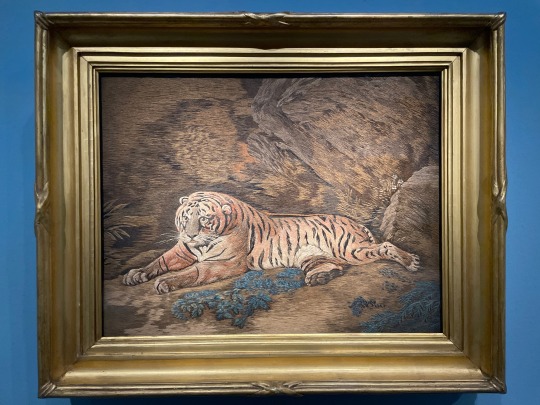
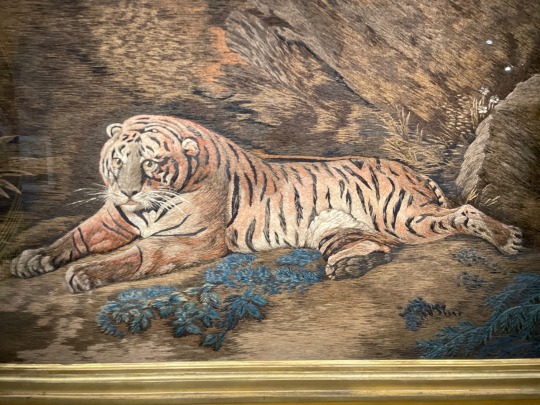

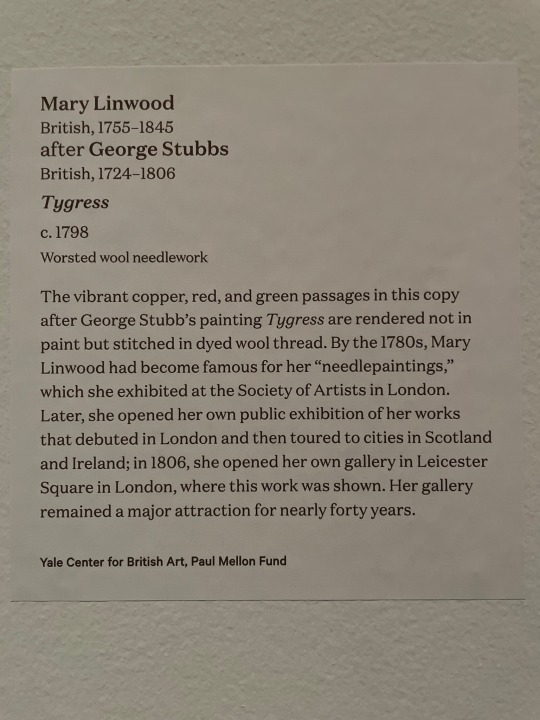
Mary Linwood (British, 1755-1845) after George Stubbs (British, 1724-1806) Tygress, c. 1798 Worsted wool needlework
“The vibrant copper, red, and green passages in this copy after George Stubb's painting Tygress are rendered not in paint but stitched in dyed wool thread. By the 1780s, Mary Linwood had become famous for her ‘needlepaintings,’ which she exhibited at the Society of Artists in London.
Later, she opened her own public exhibition of her works that debuted in London and then toured to cities in Scotland and Ireland; in 1806, she opened her own gallery in Leicester Square in London, where this work was shown. Her gallery remained a major attraction for nearly forty years.”
#animals in art#european art#18th century art#needlework#needlepainting#textiles#Mary Linwood#museum visit#exhibition#British art#George Stubbs#tiger#feline#wild cat#Baltimore Museum of Art#women artists
277 notes
·
View notes
Text

Ben Nicholson (1894–1982)
1948 (still life)
Leicester Museum & Art Gallery
18 notes
·
View notes
Text
Edmund Dulac's Fairy Tales go to War
Jstor Daily published an article with the catchy title "Edmund Dulac's Fairy Tales go to War". Of course I had to read it. The original article is here if you want to check it out, but I'll still copy-paste it below because it's crazy info. (And given it is quite long I will put two thirds of it under a cut)
Edmund Dulac’s Fairy Tales Go to War One of the best-known illustrators of the “golden age of children’s gift books,” Dulac was also a subtle purveyor of Allied propaganda during the Great War.
By: S. N. Johnson-Roehr and Jonathan Aprea ; December 16, 2022
Once upon a time, there was a young artist named Edmund Dulac, who built his early reputation on his illustrations for J. M. Dent & Company’s 1905 edition of Jane Eyre. Almost instantly, he became a leading name in the book arts, producing illustrations for the Brontë sisters and popular magazines. Annual exhibitions of his drawings and paintings at the Leicester Galleries, London, drew the attention of both the European and American art world. In 1910, critic Evelyn Marie Stuart, writing for Chicago’s The Fine Arts Journal, described his work as “rich with poetry and imagination, and strong in the possession of that decorative element which renders a picture universally pleasing.” His drawings were like "things seen in a vision or a mirage; or traced by the fancy of a child in the lichens on the wall, the water discolorations upon a ceiling, or the light shining through a broken crumpled shade; or, even like the things we try to decipher in the leaping flames and glowing embers of an open fire—many of these delightful sketches suggest to our fancy in some detail a variety of objects."
Dulac’s themes tended toward the fantastical—scenes from the Arabian Nights and Omar Khayyam’s Rubáiyát—with roots in the Pre-Raphaelites and not far removed from the work of Arthur Rackham and Kay Nielsen.
Born in France and naturalized as a British citizen in 1912, Dulac understandably awarded his loyalties to the Allies during the Great War. To support the war effort, he contributed his art and design skills to several charity books, including Princess Mary’s Gift Book and King Albert’s Gift Book, both published in 1914. If there remained any doubts as to his feelings about the Axis powers, they were surely erased when he published Edmund Dulac’s Picture-Book for the French Red Cross in 1915, with its cover proclaiming “All profits on sale given to the Croix Rouge Française, Comité de Londres.”

Even more convincing—and more inventive—was his use of fairy tales to not just further his charitable efforts but to possibly encourage the United States to join the war. Published in 1916, Edmund Dulac’s Fairy-Book was a subtle but persuasive example of wartime propaganda. Subtitled “Fairy Tales of the Allied Nations,” it included Dulac’s own adaptations of folk tales gathered from the nations fighting with Great Britain: France, Russia, Italy, Belgium, Serbia, Japan, and China.
Below, courtesy of the Minneapolis College of Art and Design, are reproductions of some of the illustrations from Edmund Dulac’s Fairy-Book, accompanied by brief explanation of each story.

Snegorotchka: A Russian Fairy Tale
Snegorotchka (more commonly transliterated Snegurochka), the “The Snow Maiden,” is a recurring character in Russian folklore, playing various roles, from child to adult, in stories bounded by the winter and spring seasons. By the late nineteenth century, Snegurochka had blended fully with the traditions of Christmas, often serving as a helper to Grandfather Frost (Ded Moroz).
In Dulac’s version of a common tale, Snegurochka is a girl made from snow, brought to life to add joy to the waning years of a childless couple. An elderly man and women all but will the girl into being as they shape a tiny body of snow in the woods. Snegurochka leaps to life, filling their home and souls with warmth throughout the winter. Tragically, the little girl disappears with the heat of spring weather, leaving the parents bereft.
Another version of the Snegurochka tale formed the basis of a play by Alexander Ostrovsky, which was subsequently adapted into an opera by Rimsky-Korsakov.

The Buried Moon: An English Fairy Tale
Sometimes known as The Dead Moon, The Buried Moon highlights the dangers of living in the bog country of Northern Europe.
Traveling through a bog, a personified Moon becomes entangled in magical, malevolent branches. After some struggle with “all the vile things” that love darkness (witch-things, bogle-bodies, creeping things, and the Scorpion King, to name a few), the Moon finds herself buried deep in the mud, held down with a black stone.
Of course the humans miss the Moon, lamenting her failure to appear in the sky on schedule, but who even knows where to search for her? Even the Wise Woman of the Mill can’t see any trace of her. Fortunately, just before her entombment, the Moon had managed to briefly shine her light to guide a lost and wandering human out of the treacherous marsh. Remembering this moment, the man spreads the word. Emboldened by the Wise Woman’s words of encouragement as well as the Lord’s Prayer, the local people march to the bog, fight off the Horrors of the Darkness, and rescue their beloved Moon

White Caroline and Black Caroline: A Flemish Fairy Tale
Folklorist Antoon Jozef Witteryck collected White Caroline and Black Caroline (Wit Karlientje en Zwart Karlientje) and included it in his 1899 Old Flemish Folktales (Oude Westvlaamsche volksvertelsels), an annotated version of which was republished by Hervé Stalpaert in 1946. The story can also be found in the Annales de la Société d’Emulation pour l’Étude de l’Histoire & des Antiquities de la Flandre (Bruges, 1889).
White Caroline and Black Caroline depends on the familiar figure of the evil stepmother, a woman who loves her ugly daughter (Black Caroline) more than her beautiful stepdaughter (White Caroline). Everyone and everything, from townspeople to lambs to dancing dogs, love White Caroline and equate her beauty with good. But the mother prefers her own daughter, noting “Black Caroline was so ugly;—but she was good all the same!”
And indeed, Black Caroline is good. Her mother tries no fewer than three times to murder White Caroline, and each time, Black Caroline intercedes. Poison thorns in the pillow, poison in her meatball dinner, an “accidentally” falling millstone—none manage to kill White Caroline, thanks to Black Caroline’s quick thinking.
The abrupt entrance of White Woman, queen of all the water and the woods, brings the murder attempts to a close. Not surprisingly, White Woman also loves White Caroline and promises to give her whatever she wishes—beautiful grapes, a dress of silk, a nice sailboat. Luckily, White Caroline is also good: she wishes to have Black Caroline with her. More than that, she wishes they could look alike. The White Woman has an idea:
“Little white feathers appeared on their shoulders and spread until they were entirely covered; and there they stood together, two beautiful white swans! And ever after they swam up and down on the peaceful water and no one could tell one from the other.”
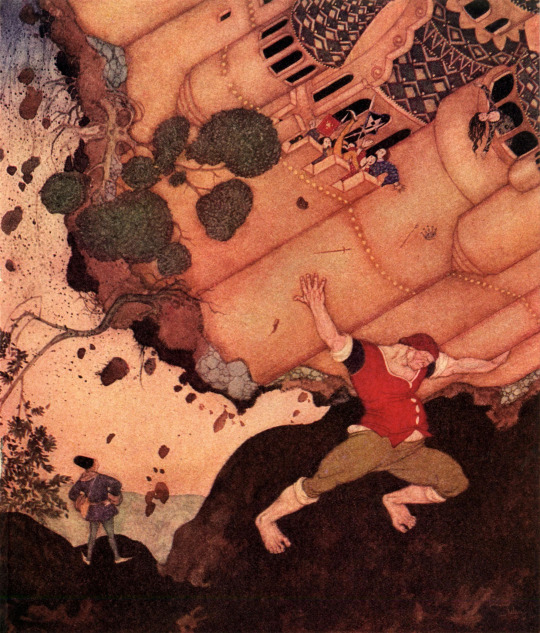
The Seven Conquerors of the Queen of the Mississippi: A Belgian Fairy Tale
While there may be an actual fairy tale underpinning The Seven Conquerors of the Queen of the Mississippi, the story’s title reveals Dulac’s probable agenda. It takes no large leap of the imagination to read the “seven conquerors” as Great Britain, France, Russia, Italy, Serbia, Japan, and China, all seeking an alliance with the Queen of the Mississippi—the United States—on the fields of Belgium.
The story is straightforward and structurally repetitive—each conqueror swears an oath of loyalty, and their individual strengths combine to win the Queen and kill the King (hello, Kaiser Wilhelm II).
Dulac, or some unnamed collaborator, has penned a verse that cuts through the first half of the tale with a modern rhythm and vocabulary.
“Will you travel with me, my pippy?” “Oh! Whither away? To Botany Bay?” “But no; to the far Mississippi, Where a Queen—tooral-ooral-i-ay— Is waiting for what I’m to say.” “I am yours! And the bounty?” “Either here or in Botany Bay!”
‘Will you travel with me, my pippy?” “Oh! Whither away? To Rome or Pompeii?” “But no; to the far Mississippi: There’s a Queen of great beauty that way, And there’s no one but Cupid to pay.” “I am yours! And the bounty?” “Name your price: it shall be as you say.” And so on. Travel with me, my pippy!
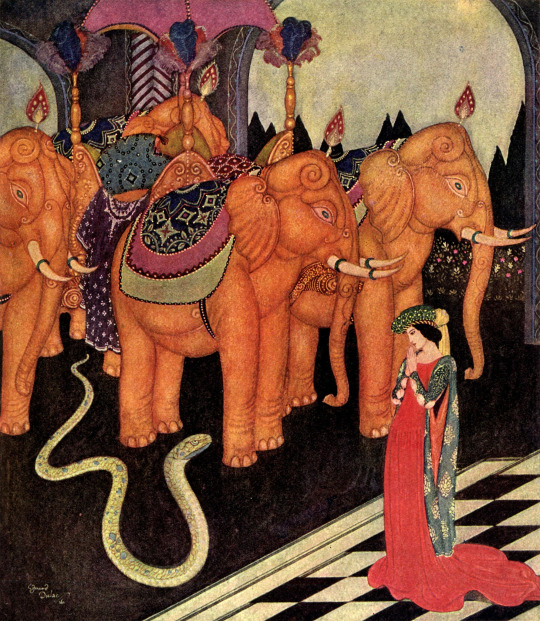
The Serpent Prince: An Italian Fairy Tale
The Italian poet Giambattista Basile collected The Serpent Prince (sometimes translated as The Enchanted Snake) in the seventeenth century, including it in The Pentamerone: Lo cunto de li cunti (The Tale of Tales). Folklorist Andrew Lang drew upon Basile’s version for The Green Fairy Book (1892).
Dulac has created his own prefatory material for the familiar story, opening with the popular nursery rhyme:
The old woman who lived in a shoe, Who had so many children she didn’t know what to do,
allegedly “lived about the same time in another part of the country” even though The Serpent Prince was collected in Naples.
As the story goes, a forester’s wife, Sapatella, finds a tiny serpent in her firewood. Childless, Sapatella is startled but amenable when the serpent offers himself up for adoption (“she was a kind-hearted woman and very, very lonely”).
The serpent grows—as children do—and soon demands a wife. And not just any wife! The serpent must marry the king’s daughter. Surprisingly, the king agrees to meet this demand. Or does he? He will give his daughter in marriage only if the adopted son-serpent can turn all the fruit in the royal orchards to gold.
It’s not clear why anyone is surprised that a talking serpent can wield the magic necessary to turn fruit into gold. Nor is it clear why the king would think the serpent would fail at any additional challenge placed before him. Turn the walls into diamonds and rubies? No problem. Turn the entire palace into gold? Absolutely (“not gold plate either: it was all solid gold of the purest kind.”). The king is forced to cede the battlefield. The princess will marry the serpent.
Of course, the serpent is really an enchanted prince, and here you would think the story would end: the affianced are wed, their kingdoms allied. But thanks to an additional foolish act by the king, the prince is again enchanted (and worse), and only the princess can save him. But will she be able to outwit the wily fox standing between her and her beloved?
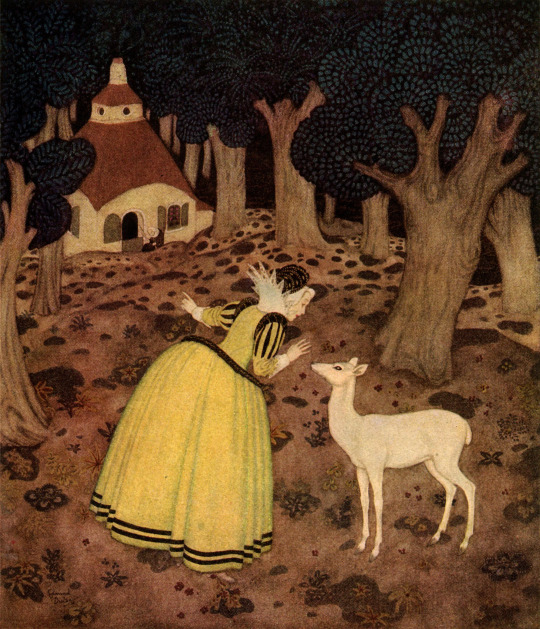
The Hind of The Wood: A French Fairy Tale
Dulac offers a faithful retelling of The Hind in the Wood (La Biche au bois, also translated as The White Doe or The Enchanted Hind), written by Marie-Catherine Le Jumel de Barneville, Countess d’Aulnoy. A talented and creative storyteller, Countess d’Aulnoy gave us the very words “fairy tale” in 1697, when she published her first collection under the title Les Contes des fees (Tales of the Fairies).
Though the titular hind is the star of the story, the scene opens with an unhappy, childless queen encountering a talking crayfish. Though “hearing a big Crayfish talk—and talk so nicely too—was a great surprise to her,” the queen listens carefully to the crustacean.
The reward for her attentiveness is a kingdom transformed. Beneath her feet appears “a carpet of violets, and, in the giant cedars above, thousands of little birds, each one a different colour, [singing] their songs; and the meaning of their melody was this: that cradle, woven by fairy fingers, was not there for nothing.” Soon she will be a mother!
A troupe of fairies gather around the suddenly expecting queen and ask that she welcome them on the day of birthing so they can give special gifts to the babe, who will be named Désirée. And on that special day, the queen indeed remembers to bid them come to the palace. Sadly, she neglects to invite the talking crayfish (who is really the Fairy of the Fountain) to the celebration.
Curses. But only small ones, in the scheme of things. The Fairy of the Fountain warns the royal parents to keep Princess Désirée from seeing daylight until she turns fifteen. That’s all.
Alas, the Warrior Prince lies on his death bed. Just a portrait of Désirée is enough to make him fall in love and abandon his plans to marry Black Princess. Yet he cannot see her—she will not be fifteen for a few more months. To save the Warrior Prince, Désirée agrees to travel with her two ladies-in-waiting by darkened carriage to his kingdom.
Unfortunately, one of those ladies-in-waiting, Long-Epine, is a traitor. She slits the cover of the carriage, exposing Désirée to daylight. Just a drop of sunlight turns the princess into a dazzling white hind. She instantly runs off into the forest. And that is the curse: by day, a doe; by night, a lonely princess.
The Warrior Prince wanders this very forest and soon spots the white deer. Annoyed that the animal tries to keeps its distance from him, he looses an arrow and pierces her flank. He’s sorry! Especially when he finds out the hind is his beloved, enchanted.
She isn’t enchanted for much longer, however. The Prince, even knowing all, loves her. And that is enough to break the spell
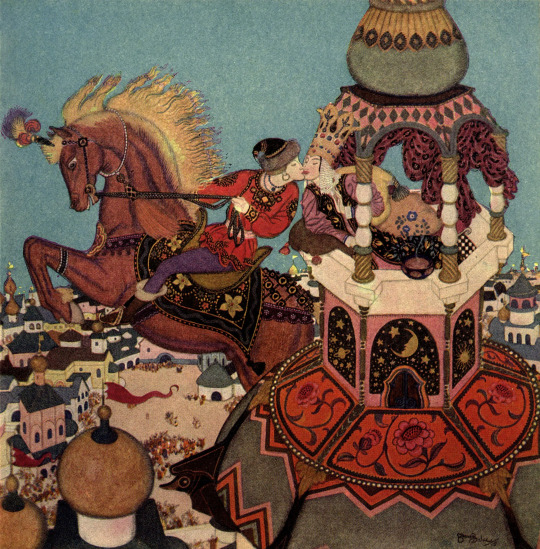
Ivan and the Chestnut Horse: A Russian Fairy Tale
Variations of Ivan and the Chestnut Horse are abundant in Russian folklore. Sometimes Ivan rides a chestnut horse, sometimes a dun. A common version of the story, known as Sivko-Burko, was collected by A. N. Afanas’ev in the mid-nineteenth century. Included in Jack V. Haney’s comprehensive The Complete Folktales of A. N. Afanas’ev (Tale #179, Vol. II), this version gives Ivan a magic black steed.
Ivan and his brothers have just committed themselves holding daily prayers over the grave of their recently departed father when they hear that Princess Helena the Fair has decided to wed. To win her favor, her suitor must leap on horseback to the top of the shrine on which she sits, kissing her as he flies through the air.
Ivan, the youngest of the siblings, offers to take on the burden of graveside prayer for a week so his brothers can curl their hair and train their horses for the challenge. One week stretches to two, and then to three. The brothers ignore their filial duties to dye their mustaches. So much attention is paid to their appearance that they even neglect to feed their horses.
And yet, when the day of the leaping contest arrives, the older brothers dash away on their mounts, leaving Ivan alone to pray and weep over his father’s grave.
It was thus that two out of three brothers miss their father’s resurrection. Shaking himself free of the damp earth, the father offers to help his youngest son. He begins to call out in a loud voice—one time, two times, three times. Ivan discovers his father is summoning a beautiful chestnut horse!
Yes, this is the enchanted steed that will take Ivan to the shrine of Helena the Fair, where—after two failed attempts—it rises to the leap, allowing Ivan to press his lips to those of the princess “in a long sweet kiss, for the chestnut horse seemed to linger in the air at the top of its leap while that kiss endured.”
After summoning the steed, Ivan’s father immediately vanishes. No matter, because Ivan is soon welcomed to supper with the father of his bride, Princess Helena the Fair.

The Blue Bird: A French Fairy Tale
The Blue Bird (l’Oiseau Bleu) is another tale that comes to us by Countess d’Aulnoy. Though there are many variants of the story found across Europe, scholar Jacques Barchilon notes that d’Aulnoy’s version is remarkably robust, appearing in a French Canadian collection, “word for word the version of Mme d’Aulnoy’s with all details,” as late as 1960. Andrew Lang also included it in The Green Fairy Tale Book.
Our story opens with a rich but miserable king. He’s inconsolable, having only recently become a widower. Hoping to comfort him, his courtiers present him with a woman dressed in mourning clothes and possibly crying even louder and longer than the king himself.
Finding solace in their similar sorrows, they decide to wed. Each brings into the marriage a daughter from their first marriage. The king’s daughter: “one of the eight wonders of the world,” the young and lovely Florine. The new queen’s daughter: “neither beautiful nor gracious,” the young Truitonne, with a face like a trout and hair “so full of grease that it was impossible to touch it.”
The queen loves Truitonne much more than she loves Florine, which wouldn’t matter if the king didn’t love the queen so much that he cedes to her every wish. For instance, he allows her to dress Truitonne in jewels and Florine in rags when Prince Charming appears at court. Despite the heavy-handed costuming, however, Prince Charming only has eyes—and love—for Florine.
The queen schemes. The queen plots. She enlists maid, frogs (“for mind you, frogs know all the routes of the universe”), and fairy godmothers. And yet the Prince will not be deflected from his plans to be with Florine. Finally, exasperated with his stubbornness, Truitonne’s fairy godmother turns the prince into a blue bird—for seven years!
It’s not too bad, at first. In bird form, the prince finds it easier to woo Florine—until the queen discovers that he flies to her window every night. Wielding her dark magic, Truitonne’s fairy godmother sends the blue bird to his nest to die.
Fortunately, every bad fairy seems to be balanced by a good fairy. This bright character finds the dying blue bird in his nest and heals him. It doesn’t seem to help much—the queen is determined that Truitonne will marry the prince even if only by trickery and deception.
The queen’s shenanigans never seem to end—this is a long fairy tale—but eventually the universe, or at the least the good fairy, finds a way to bring Prince Charming and Florine together.

The Friar and the Boy: An English Fairy Tale
The Friar and the Boy, also known as Jack and his Stepdame, reaches back to the poetry of medieval England. In volume three of Remains of the Early Popular Poetry of England (1866), William Carew Hazlitt records a c. 1585 London imprint of the chapbook verse that underpins the modern version of this tale.
The story begins with Jack, a young lad wronged by his stepmother. She starves him, she yells at him, she altogether doesn’t care for him.
One day, sent to the fields to watch the sheep, Jack encounters a hungry old man. Jack’s lunch isn’t much, as his stepmother is loathe to feed him decent food, but he gives it to the stranger. In return, the old man gives Jack three wishes.
Wish one: a bow and arrow, charmed such that the target will never be missed. Wish two: a pipe, its magic strong enough to make anyone dance who hears its tune. Wish three: an enchantment that will turn his stepmother’s harsh words into laughter.
Jack instantly puts his granted wishes to work. When his stepmother begins to scold him, her words turn to laughter. She laughs herself sick. When the Friar is sent to chastise Jack for his impudence, he ends up dancing through the brambles to Jack’s piping. Soon Jack has the entire village dancing to his tunes!
Alas, his poor old father begs for a rest. Jack loves his father, so he ceases to play. Not surprisingly, the Friar takes advantage of the pause to have Jack called before the Judge, “be-wigged and severe.”
The Friar makes his case: “the prisoner here has a pipe, and, when he plays upon it, all who hear must dance themselves to death, whether they like it or not.”
Intrigued, the Judge asks to hear this so-called Dance of Death. Jack is happy to oblige and takes up his pipe to play. Soon everyone in court is on their feet, dancing madly to the tunes. Even the judge joins in, “holding up his robes and footing it merrily.” He’s a believer, but he soon asks the boy to stop.
Jack agrees, but only if everyone promises to treat him properly.
“I think,” says the Judge, “if you will put your pipe away, they will consent to an amicable arrangement.”
Court is adjourned.
The End.
#edmund dulac#fairytale illustrations#fairytale art#french fairytales#british fairytales#english fairytales#edmund dulac's fairy book#world war I#wwI#fairytales and war#fairytale propaganda#russian fairytales#belgian fairytales#flemish fairytales#edmund dulac's fairy-book#italian fairytales#political fairytales
11 notes
·
View notes
Text

May Memories
Artist: Ford Madox Brown (British, 1821-1893)
Date: 1821-1893
Medium: Oil on canvas
Collection: The Leicester Galleries, London, England
Description
Ford Madox Brown began this painting of his second wife, Emma, at his house in Fitzroy Square, London in 1869, retouching and finally working it up for sale in Manchester in May 1884. His first wife had died in Rome in 1846. He married again in 1853. Emma Hill had been his model and lover since 1848.
The year 1870 began as one of some depression does, and held on its course rather languidly. No pictures new in subject were commenced, but designs for pictures, subsequently executed, had their origin in the already referred to illustrations of Moxon's ‘Byron’. The early part of the year was occupied by the painting of a ‘fancy portrait’ of Mrs Madox Brown, entitled May Memories, of a lady of sumptuous charms sitting amongst a wealth of may-blossoms, meditating on the glories of her may-days in the ‘temps jadis’. This picture was, however, not finished until long subsequently.
Madox Brown was never a member of the Pre-Raphaelite Brotherhood (being deemed too old at twenty-eight in 1848), but he was a close associate through his lifelong friendship with Rossetti. He influenced the Brotherhood’s admiration for early Italian art, encouraged them to paint in pure glazes and was, in turn, influenced by their fidelity to nature.
#painting#oil on canvas#fine art#may memories#woman#genre subject#british culture#dress#flowers#pre raphaelite style#pre raphaelite brotherhood#artwork#lace shawl#ford madox brown#genre art#british painter#british art#19th century painting#european art
11 notes
·
View notes
Text

@narwa submitted: hello! heres some (i can count about 9 on this photo) stick bugs from leicester museum and art gallery. they also have a colony of madagascar hissing cockroaches but i forgot to take a picture. some of them waved very slowly and i was sooo convinced they were just parts of the plants. totally.
Seriously impressive camouflage! I see nothing but plants here :)
51 notes
·
View notes
Text



A few photos from this weekend...
#london#culture#artist#british artist#female artists#art studio#contemporary artist#creativity#two queens#save two queens#leicester artist#two queens studios and gallery leicester#photography
0 notes
Text

Micheal Jackson 2023 - Original Painting
#artists on tumblr#painter#painting#art#portrait painting#portrait#abstractart#art gallery#artdealer#artcollector#art commissions#leicester
2 notes
·
View notes
Text

Keep Yourself Alive 2017 - Original Painting inspired by Jean-Michel Basquiat.
#art#painting#leicester#artist#artists on tumblr#painter#abstractart#artgallery#abstract#artcollector#abstract painting#art gallery#art collectors#art dealer#interior design#jean michel basquiat#basquiat
2 notes
·
View notes